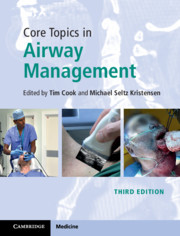Book contents
- Core Topics in Airway Management
- Core Topics in Airway Management
- Copyright page
- Contents
- Contributors
- Foreword
- Preface to the Third Edition
- Section 1 Airway Management: Background and Techniques
- Section 2 Airway Management: Clinical Settings and Subspecialties
- Chapter 22 The Airway in Obstetrics
- Chapter 23 The Paediatric Airway
- Chapter 24 Airway Management in Obesity
- Chapter 25 Maxillofacial and Dental Surgery
- Chapter 26 Ear, Nose and Throat Surgery: Airway Management
- Chapter 27 Lung Separation
- Chapter 28 Airway Management in the Critically Ill
- Chapter 29 The Patient with a Tracheostomy
- Chapter 30 Pre-hospital and Trauma Airway Management
- Chapter 31 Airway Management during CPR
- Chapter 32 The Bloody and Bleeding Airway
- Chapter 33 The Airway in Anaesthesia for Transoral Robotic Surgery
- Section 3 Airway Management: Organisation
- Index
- References
Chapter 31 - Airway Management during CPR
from Section 2 - Airway Management: Clinical Settings and Subspecialties
Published online by Cambridge University Press: 03 October 2020
- Core Topics in Airway Management
- Core Topics in Airway Management
- Copyright page
- Contents
- Contributors
- Foreword
- Preface to the Third Edition
- Section 1 Airway Management: Background and Techniques
- Section 2 Airway Management: Clinical Settings and Subspecialties
- Chapter 22 The Airway in Obstetrics
- Chapter 23 The Paediatric Airway
- Chapter 24 Airway Management in Obesity
- Chapter 25 Maxillofacial and Dental Surgery
- Chapter 26 Ear, Nose and Throat Surgery: Airway Management
- Chapter 27 Lung Separation
- Chapter 28 Airway Management in the Critically Ill
- Chapter 29 The Patient with a Tracheostomy
- Chapter 30 Pre-hospital and Trauma Airway Management
- Chapter 31 Airway Management during CPR
- Chapter 32 The Bloody and Bleeding Airway
- Chapter 33 The Airway in Anaesthesia for Transoral Robotic Surgery
- Section 3 Airway Management: Organisation
- Index
- References
Summary
The priorities of airway management during cardiopulmonary resuscitation are to minimise interruptions in chest compressions, to optimise blood flow and oxygen delivery to vital organs and to minimise delays in defibrillation if the initial rhythm is shockable. Thus, during the initial treatment of cardiac arrest, unusually, the circulation takes priority over the airway. Maintaining a patent airway will enable ventilation and oxygenation of the lungs, which becomes increasingly important after the first 3–4 minutes of sudden primary cardiac arrest (i.e. of cardiac cause). The optimal airway management strategy during cardiac arrest is uncertain. Many cardiac arrest patients are treated with multiple airway devices and this stepwise approach to airway management is difficult to study in controlled trials. The results of three recent randomised clinical trials suggest tracheal intubation should only be used in those settings with a high intubation success rate. While early oxygenation and ventilation are logically more important after asphyxial cardiac arrest existing resuscitation guidelines recommend the same sequence of actions regardless.
Keywords
- Type
- Chapter
- Information
- Core Topics in Airway Management , pp. 278 - 281Publisher: Cambridge University PressPrint publication year: 2020



